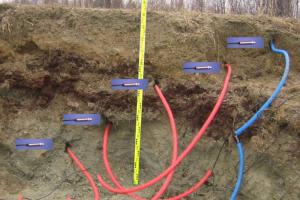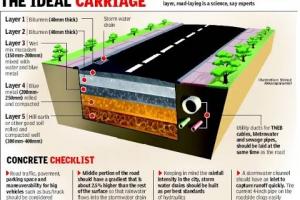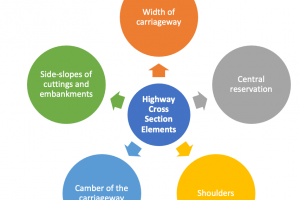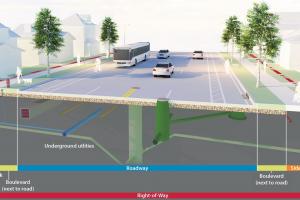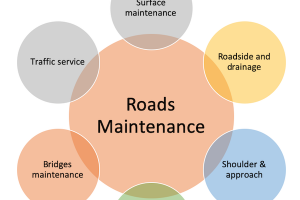Types of Pavements - Flexible Pavement / Rigid Pavement

Following are the two main types of pavements:
- Flexible pavement
- Rigid pavement
Flexible pavement:
Are those pavements which reflect the deformation of subgrade and the subsequent layers to the surface.
Rigid pavement:
The rigid characteristic of the pavement are associated with rigidity or flexural strength or slab action so the load is distributed over a wide area of subgrade soil.
Flexible pavement:
Definition
Flexible pavements are those pavements which reflect the deformation of subgrade and the subsequent layers to the surface. Flexible, usually asphalt, is laid with no reinforcement or with a specialized fabric reinforcement that permits limited flow or repositioning of the roadbed under ground changes.
![]() The design of flexible pavement is based on load distributing characteristic of the component layers. The black top pavement including water & gravel bound macadam fall in this category.
The design of flexible pavement is based on load distributing characteristic of the component layers. The black top pavement including water & gravel bound macadam fall in this category.
Also See: Road Types
![]() Flexible pavement on the whole has low or negligible flexible strength flexible in their structural action). The flexible pavement layers transmit the vertical or compressive stresses to the lower layers by grain transfer through contact points of granular structure.
Flexible pavement on the whole has low or negligible flexible strength flexible in their structural action). The flexible pavement layers transmit the vertical or compressive stresses to the lower layers by grain transfer through contact points of granular structure.
![]() The vertical compressive stress is maximum on the pavement surface directly under the wheel load and is equal to contact pressure under the wheels. Due to the ability to distribute the stress to large area in the shape of truncated cone the stresses get decreased in the lower layer.
The vertical compressive stress is maximum on the pavement surface directly under the wheel load and is equal to contact pressure under the wheels. Due to the ability to distribute the stress to large area in the shape of truncated cone the stresses get decreased in the lower layer.
![]() As such the flexible pavement may be constructed in a number of layers and the top layer has to be strongest as the highest compressive stresses.
As such the flexible pavement may be constructed in a number of layers and the top layer has to be strongest as the highest compressive stresses.
![]() To be sustained by this layer, in addition to wear and tear, the lower layer have to take up only lesser magnitude of stress as there is no direct wearing action due to traffic loads. Therefore, inferior material with lower cast can be used in the lower layers.
To be sustained by this layer, in addition to wear and tear, the lower layer have to take up only lesser magnitude of stress as there is no direct wearing action due to traffic loads. Therefore, inferior material with lower cast can be used in the lower layers.
Rigid pavement: Definition
The rigid characteristic of the pavement are associated with rigidity or flexural strength or slab action so the load is distributed over a wide area of subgrade soil. Rigid pavement is laid in slabs with steel reinforcement.
![]() The rigid pavements are made of cement concrete either plan, reinforced or prestressed concrete.
The rigid pavements are made of cement concrete either plan, reinforced or prestressed concrete.
![]() Critical condition of stress in the rigid pavement is the maximum flexural stress occurring in the slab due to wheel load and the temperature changes.
Critical condition of stress in the rigid pavement is the maximum flexural stress occurring in the slab due to wheel load and the temperature changes.
![]() Rigid pavement is designed and analyzed by using the elastic theory.
Rigid pavement is designed and analyzed by using the elastic theory.
Advantages of Rigid Pavement
-
Rigid lasts much, much longer i.e 30+ years compared to 5-10 years of flexible pavements.
-
In the long run it is about half the cost to install and maintain. But the initial costs are somewhat high.
-
Rigid pavement has the ability to bridge small imperfections in the subgrade.
-
Less Maintenance cost and Continuous Traffic and Flow.
-
High efficiency in terms of functionality
Comparison of Flexible and Rigid Types of Pavements
|
|




